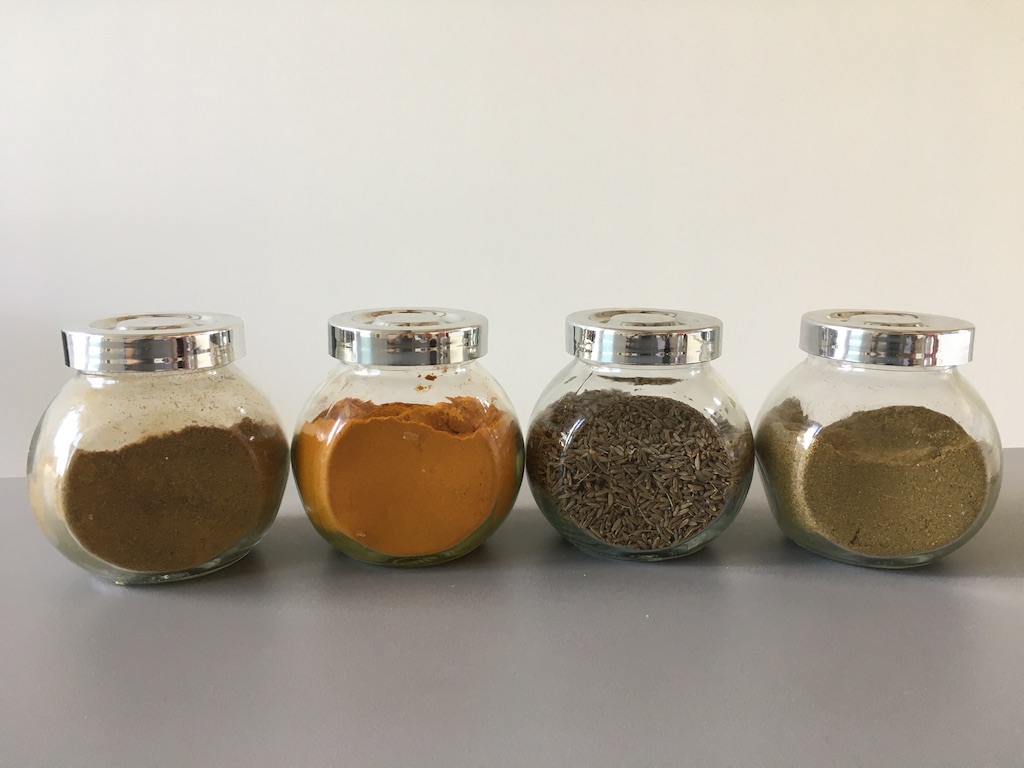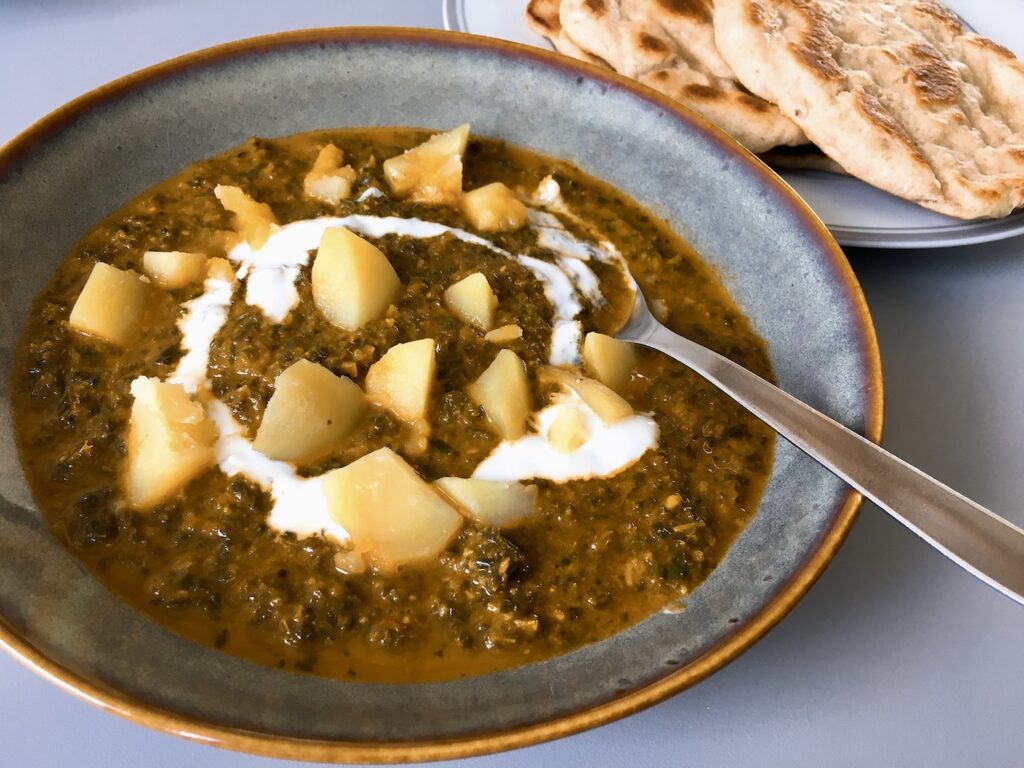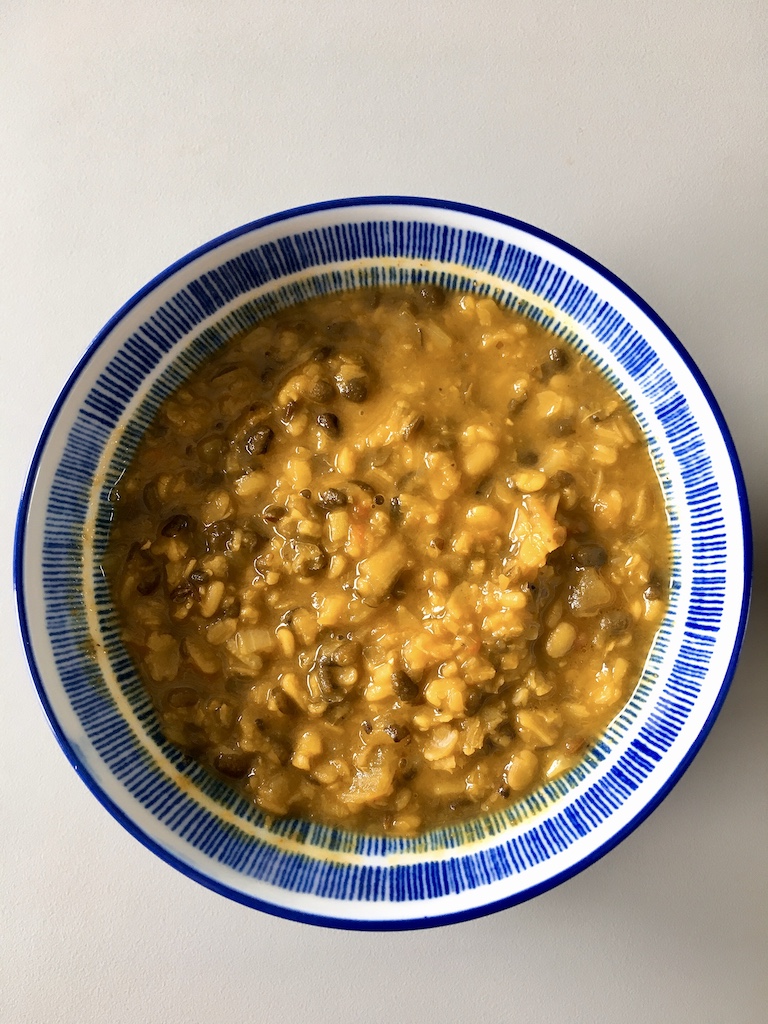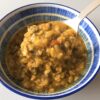Indian vegetable curry is my family’s dinner on every Sunday: a sabzi (vegetable curry) and a bowl of dal soup (split pulses soup), allow us to easily eat up to 10 different vegetables in one meal. They are not difficult to cook. Get the masala (curry base) right, add in the vegetables you like, the taste won’t go wrong.
I won’t start to cook Indian food if my husband were not Indian. And those Indian curry I eat in restaurants are always very spicy, where I usually only order butter chicken because it’s mild and easy to eat.
I still remember the first time I went to Curry Boy’s hometown, and I was worried that his Mom’s cooking would be very spicy. It turned out that I was worried for nothing. His family also eats very mild food, and they don’t put a lot of chilli. That’s the difference between North India and South India.

Gather the Basic Spices
First, let’s talk about the spices.
Basic spices: To us, there are only 4 must-have spices, which are cumin seeds , ground turmeric, ground coriander and garam masala.
Garam masala is considered to be the most important one, since it is a mixed spices, meaning that if you have nothing else on hand, garam masala can more or less provide you the basic curry flavours.
Chilli : Many Indian recipes use fresh green chilli, but it’s not in our case, since it’s quite hot and can’t be kept for too long. So, we prefer dried chilli. Sometimes we use it as a whole, without deseeding it; sometimes we do. It’s good to keep testing to find your most preferable chilli hotness.
Oil : We normally use ordinary vegetable oil. If we want a more fragrant dish, we will use ghee (clarified butter), but it is not necessary.
What about curry powder?
Curry powder also is a mixed spices, a product derived in England, for the English to cook Indian food. If you look close to their ingredients, you’ll find they have something in common – usually contain coriander, cumin and black pepper. While curry powder often has turmeric so its colour is yellowish, and it contain little salt as well. Since both of their spice profile is different, the flavour would be differed as well. But Indian usually don’t use curry powder, as they like to first pick their favourite garam masala, and then add other spices, which gives them more control.
Now, let’s go into the cooking part.
Simple Steps to Basic Indian Vegetable Curry

I like to think Indian curry cooking process divided into 2 parts: masala and sabzi (vegetable curry) or dal soup (split pulses soup).
Masala : aka the curry base, or you can call it the curry paste. Fry the whole spices, add onion, garlic and ginger to slowly cook, then add tomatoes and again slowly cook, add ground spices, done.
Sabzi : prep and chop all the vegetables you like, then mix them with the masala.
Once your masala is on spot, whichever vegetables to add in is entirely up to you. Potatoes and carrots can be popular, while the other choices can be broccoli, cauliflower, frozen green beans, frozen beans and so on.
I especially recommend frozen vegetables as they are really a good helper. Besides having a long shelf life, they are usually cut and washed, which saves a lot of time.
Dal : first, decide the pulse you’re going to use, needed to be soaked in advance or not. In our case, we do like this:
(A)Soak overnight : chickpeas, kidney beans
(B)Soak few hours ahead : black-eyed peas, pigeon peas (toor dal)
(C)No need to soak : any colour of lentils
For group (A), I usually pressure cook it in salted water (1% salt) for 10 mins, release gas naturally. Save the broth for the curry.
For group (B) and (C), cook normally in salted water (also 1% salt) for about 15-20 minutes, or until they are soft enough. Save the broth for later use.
Combine the cooked pulses/legumes with the masala, mix well, then off you go to enjoy!

Note: I didn’t like any kind of legumes since it can cause bloating. I tried to stay away from them. But as I gradually eating more pulses, the problem of bloating also got improved! I guess my body is getting used to it.
Cooking Indian curry may give people the impression that it requires many steps and turned out greasy. In fact, as long as there are enough spices and you are willing to spend a little time to chop some vegetables, the curry can be made in as little as 30 minutes (like the dal!).
The amount of oil used and seasoning can be adjusted by yourself. The spices used in the curry play the magic that, even without meat, you don’t feel missing anything. I think that delicious vegetarian curry is one of the great ways for us to eat a lot of vegetables easily.
More Indian Vegetable Curry to Try
- Vegetables with Tomato Cream Sauce Curry
- Curry Boy’s Split Black Gram Soup(Urad Dal)
- Spiced Chickpea Meatball(Vegan Kofta)
- The Happy Pear Chickpea Curry (Steps-Cut Chana Masala)
- Sweet and Sour Butternut Squash (Vegan)
- Kale Potato Indian Curry (Vegan)


